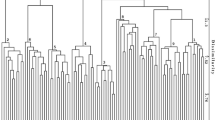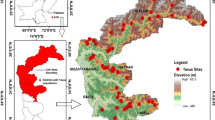Abstract
Prediction of potential natural vegetation (PNV) requires autochthonous species distributions of a benchmark phytocoenosen. In Korea there remained unique forests or groves, i.e. a traditional Ma-Eul-Soop (MES), in the foothill zone which has influenced by the most aggressively anthropogenic activities since the Neolithic Age. Sachon-ri’s Garo-Soop (SGS) located at the southern-eastern Korean Peninsula has been reputed as the best conserved MES in Korea. We studied SGS for identifying components of the PNV. A total of 1,959 trees in the SGS were measured finescaled GPS locations and diameter at breast height (DBH). Distribution patterns of major species were interpreted by using the MES species ranking class (MSRC) framed by a matrix of phytogeographical and phytosociological autochthons. We consequently found that the SGS was composed of 29 autochthonous species. Cornus walteri, Hemiptelea davidii, Quercus aliena, Zelkova serrata, and Celtis sinensis were identified as the best matched PNV species to the floodplain behind riverbank. A lot of saplings occurring at the forest floor were the major components of PNV too. By the way many allochthonous species have been consistently introduced into the SGS in terms of a man-made forest of most previous works. We suggested that such PNV-unfriendly managements should be promptly stopped.
Similar content being viewed by others
References
Bohn U (1995) International project for the construction of a map of the natural vegetation of Europe at a scale of 1:2.5 million–its concept, problems of harmonization and application for nature protection. Colloq Phytosiol 23:24–25
Carranza ML, Ricotta C, Fortini P, Blasi C (2003) Quantifying landscape change with actual vs. potential natural vegetation maps. Phytocoenologia 33:591–601
CHA (Cultural Heritage Administration) (2008) Manual for conservation management of Ma-Eul-Soop. CHA, Seoul, KR
Cho KJ, Kim JW (2005) Syntaxonomy and synecology of the Robinia pseudoacacia forests. Korean J Ecol 28:15–23
Choi JU, Kim DY (2000) A study on the structure and conservation condition of rural community forests as culture in Korea. J Korean Inst Tradit Landsc Archit 18:51–64
Choi JU, Kim DY, Kim ME, Kang BH, Jeong MC, Jo LW, Kim SB (2011) Current State of the Roadside Forest in Sachon-ri, Uiseong and the Perspectives on the Name of the Natural Monuments. J Korean Inst Tradit Landsc Archit 29:52–60
Härdtle W (1995) On the theoretical concept of the potential natural vegetation and proposals for an up-to-date modification. Folia Geobot 30:263–276
Jang DS, Lee KM, Kim HB (1993) A study on the tendency and characteristics of planted forests in Kyung-Sang-Do province. J Korean Inst Tradit Landsc Archit 11:77–89
Jang EJ, Kim JW (2007) Ecology & Culture of the Old-Growth and Giant Trees of Traditional Village. Worldscience, Seoul, KR
Jegal JC, Kim JW (2003) A phytosociological comparison of forest vegetation between igneous and sedimentary rock areas in Kyungpook province, South Korea. Korean J Ecol 26:23–28
Kang HK, Bang KJ, Lee SJ, Kim HB (2004) Management Guidelines of Village Groves through an Analysis of Growth Environments -Focusing on Village Groves in Gyungsang and Gangwon Provinces-. J Korean Inst Tradit Landsc Archit 22:63–74
Kang W, Koh I, Park C-R, Lee D (2012) An Analysis of Changes in Forest Fragmentation and Morphology in Surrounding Landscapes. Korean J Environ Ecol 26:941–951
Kim HB (1992) A study on the cultural background of village grove. Yonam Jr Coll Livest Hortic 11:239–257
Kim HB, Jang DS (1993) A study on the origin of Korean village grove mentioned in ancient documents. J Korean Inst Tradit Landsc Archit 11:19–40
Kim HB, Jang DS (1994) Maeulsup, The Korean Village Grove. Youlhwadang, Seoul, KR
Kim HB, Jang DS, Lee SJ (2003) A Study about Improved Plans of Management of Korean Village Groves. J Korean Inst Tradit Landsc Archit 21:90–99
Kim HB, Jang DS, Park BJ (2008) A study on the course of restoration of traditional village grove. J Korean Inst Tradit Landsc Archit 26:42–50
Kim JW (1990) A syntaxonomic scheme for the deciduous oak forests of South Korea. Abstracta Botanica 14:51–81
Kim JW (2005) Viewpoint of Pinus densiflora based on Bursaphelenchus xylophilus and forest fire in the eastern coast of Korea. Korean J Ecol 28:113–120
Kim JW (2006) Vegetation Ecology, 2nd edn. World Science, Seoul, KR
Kim JW, Lee JA, Lim JC, Hwang SY (2011) The origin and preservation of relic forests and confucianism in Korea. Acta Koreana 14:195–223
Kim JW, Lim JC (2006) A Phytosociological review of the village forests (Maeul-soop) based on traditional folk belief in South Korea. Journal of Keimyung Korean Studies 33:81–112
KMA (Korea Meteorological Administration) (2009) Annual climatological report. Korea government administrative publication, Seoul, KR
Koh I, Reineking B, Park C-R, Lee D (2015) Dispersal potential mediates effects of local and landscape factors on plant species richness in maeulsoop forests of Korea. J Veg Sci 26:631–642
Lee DB (1963) Study of Bang Joong Hyang Yak Mok in Hyang Yak Gu Geup Bang. Journal of Asiatic Studies 6:339–364
Lee WT, Yim YJ (2002) Phytogeography. Kangwon University Press, Chuncheon, KR
Lim JC (2008) Plant species composition and distribution pattern of Maheul-Soop (Traditional Village Forest). MS thesis. Keimyung University, Daegu, KR
Lim JC (2012) A Phytosociological Study of the Maeul-Soop in Korea. Ph.D. thesis. Keimyung University, Daegu, KR
Miyawaki A, Fujiwara K (1988) Vegetation mapping in Japan. In: Küchler, AW, Zonneveld IS (eds) Vegetation mapping. Springer Netherlands, pp 427–441
Mucina L (2010) Floristic-phytosociological approach, potential natural vegetation, and survival of prejudice. LAZAROA 31:173–182
NCPRI (National Cultural Properties Research Institute) (2002) Seasonal customs of Gyeongsangbuk-do. NCPRI, Daegeon, KR
Neuhäusl R (1984) Umweltgemasse natürliche Vegetation, ihre Kartierung und Nutzung für den Umweltschutz. Preslia 56:205–212
Park JC, Kim BS, Yun SH, Park SM (2004) A study on the restoration of Neunggil village forests in Jinan. J Korean Soc Rural Plan 10:27–32
Podani J (2001) SYN-TAX 2000. Computer programs for data analysis in ecology and systematics. User’s manual. Scientia, Budapest, HU
Ricotta C, Carranza ML, Avena G, Blasi C (2000) Quantitative comparison of the diversity of landscapes with actual vs. potential natural vegetation. Appl Veg Sci 3:157–162
Tüxen R (1956) Die heutige potentielle natürliche vegetation als gegenstand der vegetationskartierung. Angew. Pflanzensoziologie 13:5–42
Westhoff V, van der Maarel E (1978) The Braun-Blanquet approach. In: Whittaker RH (ed) Classfication of Plant Communities. Junk, The Hague, pp 287–399
Zerbe S (1998) Potential natural vegetation: validity and applicability in landscape planning and nature conservation. Appl Veg Sci 1:165–172
Author information
Authors and Affiliations
Corresponding author
Rights and permissions
About this article
Cite this article
Lim, JC., Choi, BK., Kim, SY. et al. Korean traditional village forest (Ma-Eul-Soop) and potential natural vegetation: A case study on the Sachon-Ri Garo-Soop in Gyeongsangbuk-do, South Korea. J. Plant Biol. 59, 515–524 (2016). https://doi.org/10.1007/s12374-015-0572-0
Received:
Accepted:
Published:
Issue Date:
DOI: https://doi.org/10.1007/s12374-015-0572-0




